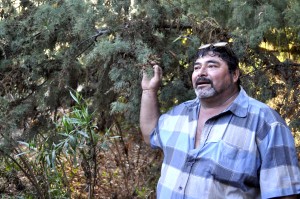
Massive 18-foot iron border wall cuts through the pristine Jacumba Mountains Wilderness area in Imperial County, California
In a surprising and welcome move this week, the national board of the Sierra Club voted on Wednesday to support comprehensive immigration reform. The move unifies the Sierra Club and the already powerful immigrant rights movement, bringing hefty political clout to the support of a pathway to citizenship for the nation’s eleven million undocumented immigrants.
In a statement released this morning, Sierra Club’s Executive Director Michael Brune and President Allison Chin affirmed the commitment of the club to work together with other organizations committed to democracy, equality AND the environment.
“The Sierra Club is committed to partnering with all who share our urgent concerns about advancing our democracy and fighting the climate crisis. It is time for us to work together,” they write.
“That is why the Sierra Club Board of Directors has voted to offer our organization’s strong support for a pathway to citizenship for undocumented immigrants. Such a pathway should be free of unreasonable barriers and should facilitate keeping families together and uniting those that have been split apart whenever possible.”
This new policy marks a major shift for the nation’s oldest environmental organization. The Sierra Club continues to oppose the construction of border walls, and opposes the waiver authority granted to the Department of Homeland Security secretary to speed construction of walls and infrastructure. The club has articulated a clear critique of NAFTA, and has officially taken a stand linking undocumented immigration to the economic crisis prompted by NAFTA in Mexico. But they have stopped short, until now, of taking a position on Comprehensive Immigration Reform that would enable to them clearly join forces with immigrant rights groups.
The difficulty of this kind of base building across disparate sectors in the world of public policy advocacy is the subject an emerging body of scholarship on human rights and environmentalism. As Romina Picolotti and Jorge Daniel Taillant pointed out in their introduction to the anthology Linking Human Rights and the Environment (Tucson, 2003), in spite of the fact that current problems of environmental degradation have a disproportionate impact on the most vulnerable, marginalized populations, human rights organizations and environmentalists have historically framed these issues in ways that travel along separate legislative tracks.
The Sierra Club forged a position of official neutrality on the question of immigration in the course of a lengthy crisis of identity and political integrity. As early as 1996, nativist forces began attempting to sway environmentalists to the anti-immigration camp, framing popular racist arguments about immigration and population control in terms of “environmental ethics” and the commitment to sustainability.
In 1998, the internal division reached a crisis point, when the Sierra Club’s nativist forces joined together under the name Sierrans for U.S. Population Stabilization (SUSPS) and joined anti-immigrant groups eager to mobilize the Sierra Club’s membership to oppose immmigration reform. When faced with the decision whether to adopt a nativist plank, the Sierra Club rejected the anti-immigrant hysteria and voted 60% to 40% to remain neutral on the question of immigration. The SUSPS then changed tactics, and over the course of the next five years, began a stealth campaign to elect nativist members on the national board of the Sierra Club.
Alerted to their nativist agenda by the Southern Poverty Law Center, Sierra Club leaders successfully mobilized membership to oppose nativist, anti-immigrant policies. But the opposition left them with a position of neutrality.
Thus, the Sierra Club’s decision this week is a huge step forward. Building bridges between human rights and environmentalism may also help shine some light on migrants’ struggles to preserve the integrity of their communities and natural environment.

Members of the community of Granjas Familiares in eastern Tijuana fight to preserve the Arroyo Alamar
The struggle to save the Rio Alamar (Arroyo Alamar in Spanish) is a case in point. For over a decade, the immigrant communities of Chilpancingo and Granjas Familiares in Tijuana have been working together with San Diego’s Environmental Health Coalition to preserve the natural environment and fight back against local factories who dump toxic wastes into the Arroyo Alamar.
The course of the Arroyo Alamar crosses back and forth several times between the United States and Mexico. Thus, the toxic wastes dumped by maquiladoras on one side of the border have deep impacts on the people and communities of the entire watershed.
Significant impacts can be felt in both San Diego and Tijuana. The community of Granjas Familiares, first impacted by the presence of toxins in their drinking water and air, are now threatened by a plan to channelize the river. Waste products of all kinds make their way down river, crossing into San Diego and ending up in the rivers & wildlands of San Diego County. Thus, the potential success of migrants in Tijuana will go a long way in preserving the integrity of San Diego as well.
The struggle for the Arroyo Alamar demonstrates two important points: first, that immigrants care deeply about environmental preservation. And second, that environmentalism cannot be separated from the struggle to protect people, families and communities.
As Brune and Chin write in their statement, “We must ensure that the people who are the most disenfranchised and the most affected by pollution have the voice to fight polluters and advocate for climate solutions without fear.”
Migrant, citizen, legal resident, California native: the environment belongs to us all.
